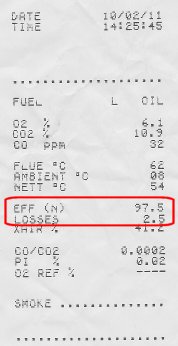Gas and oil fired boiler efficiency
When installing a new oil or gas fired boiler or furnace it is important to ensure that the new boiler has the capacity to meet the peak heat demand. The way this is calculated is by knowing the temperatures of the rooms, the lowest temperature you intend you boiler to cope with and the heat conductance of the various surfaces to the outside. There are many methods/ tools to help with this and they are discussed elsewhere.
Looking at the old boiler in our home the rating plate shows the following…
| BTU/hr | MJ/h | kW | |
| Input | 100,000 to 114,300 | 105.5 to 120.6 | 29.3 to 33.5 |
| Output (heat into water) | 75,000 to 86,000 | 79.1 to 90.7 | 22.0 to 25.2 |
| Output (heat to air) | 4,000 | 4.22 | 1.17 |
As a side note the rating notice shows that the boiler was built for Town Gas and converted. So it must have been built befor 1977 and installed or converted between 1967 and 1977 when the staged changeover took place; it has provided over 30 year’s service. Hope the new boiler does as well!
Below the rating table is a table of injector sizes and pressures. For Natural Gas there is only one injector size and the unit is marked as having been set to the lowest burner pressure. So the assumption is that the boiler is rated to run at 100,000 BTU/hr – 105.5 MJ/h – 29.3kW.
So what is the efficiency of this boiler?
I suspect that the manufacturer would claim that is has an efficiency of 79%.
That is, for BTU, (75,000 + 4,000)/ 100,000.
But a proportion of this is wasted as direct heat into the location where the boiler is located. This results in an unoccupied room that is the hottest in the house by far. I suspect that the heat ‘lost’ in this way is greater than the originally rated 1.17kW!
Modern boilers tackle this measurement in a different way as a certificate of efficiency is given to the householder on completion of installation. In the example on this ticket the installer of an oil fired boiler has measured the output flue temperature and uses this to calculate the efficiency.

Boiler Performance Ticket
How is the 97.5% calculated?
First start from the flame temperature. Here are the figures for some common heating substances
Flame temperatures for some common fuels |
|
| Fuel | Flame temperature |
| Natural gas
Kerosine Light fuel oil Medium fuel oil Heavy fuel oil Bituminous Coal Anthracite |
2,070
2,093 2,104 2,101 2,102 2,172 2,180 |
From the ticket we see the exhaust temperature is 62C, that is +54C relative to ambient.
So heat loss can be calculated from
(Excess exhaust temperature/ Excess flame temperature).
(62-8)/(2,101-8), that is 2.58% giving an overall efficiency of 97.42%. It seems that there is a little bit of ‘rounding’ going on in the ticket calculator.
A full calculation would take into account the heat content of the original gas or oil and the amount of hot water and local waste heat produced. However, such calculations involve a huge amount of detail and so are complex for the non technical person to discover and measure. The method above is simple and understandable – and pretty accurate.